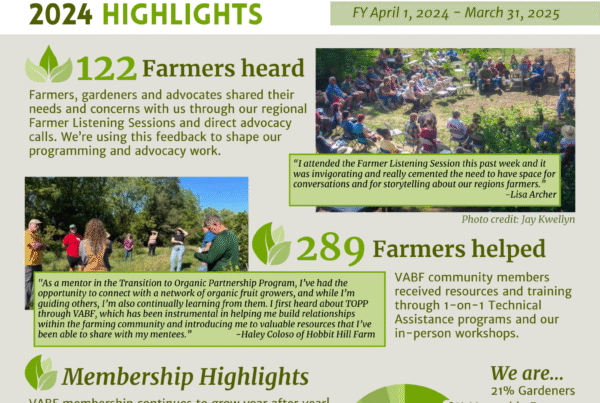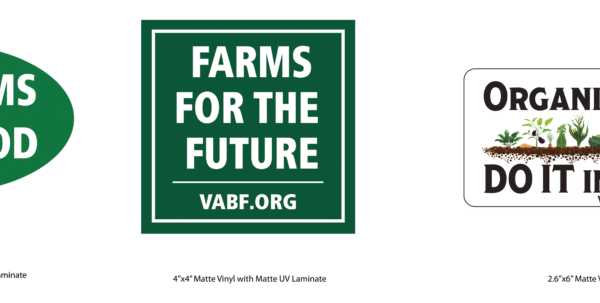On my way home from Richmond on March 26 of this year, I stopped at Bellair Farm, to interview VABF member Jamie Barrett, who has established a successful Community Supported Agriculture (CSA). Located about ten miles south of Charlottesville, Bellair Farm is an historic 900 acre farm, with a large plantation style farmhouse, about 100 acres tillable cropland, and the rest in pasture, riparian zone, and forest. After leasing land to conventional corn, soybean, and hay producers for 35 years, Bellair Farm’s current owner Cynthia Davis hired Jamie early in 2011 to launch an organic vegetable and fruit enterprise.
I first met Jamie that spring, when he contacted me for help with soil test recommendations. When I visited the farm to take soil samples from several multi-acre fields, I was struck by the challenges he had taken on. With plans to launch a 150-member CSA that very season, Jamie started with land tired from years of row crop farming, low in nutrients and organic matter. In the sandy bottomland, located in the 100-year floodplain of the Hardware River, we found a thick hardpan starting 8 inches below the surface. The loamy upland soils had a more open profile, but the reddish color of the soil surface evidenced a need to rebuild organic matter and soil life. I developed recommendations based on what we saw in the field as well as the numbers on the soil test reports, then left it up to the farmer and nature to collaborate in transforming words and figures into practical results.
Three years later, I had an opportunity to return to Bellair Farm for a workshop on organic crop pest and disease management, co-presented in July, 2014 by Jim Hankins of the Virginia State Small Farm Outreach Program, Ellen Polishuk of Potomac Vegetable Farms, and Dr. Anton Baudoin, plant pathologist at Virginia Tech (See Full Articles for Third Quarter 2014 at https://vabf.org/news/newsletter/). Although we did find a few pests and diseases on our field walk, the signs of success were many: improving soils, abundant crops, and a packing shed with walk-in coolers, produce list boards, and other infrastructure to support a thriving CSA program. In addition, Bellair Farm hosted a series of workshops in 2014 for gardeners, homesteaders, and small scale farmers, and invited me back last fall to give a talk on natural soil improvement.
On my most recent visit, Jamie and his assistant manager Michelle McKenzie took time out of their busy schedule to give me a personal tour of their farm, going from field to field in their trusty old pickup. We first stopped at an 11-acre field where this year’s crops include potatoes (already planted, on St. Patrick’s Day), onions, leeks, and garlic. “Potato planting is a big job, and we want to get them in early,†Jamie and Michelle explained, adding that this was one of their newer fields, transitioned into organic vegetables after spending the 2014 growing season in a clover + forage radish cover crop.
Jamie expressed much satisfaction with the organic transition process at Bellair Farm, working with owner Cynthia and with Kevin Engell, the conventional grower to whom she had been renting cropland. Kevin continued to farm parts of Bellair during Jamie’s first few years, growing soybeans without synthetic inputs, followed by a winter cover crop of barley and crimson clover to help transition fields into USDA certified organic vegetables. In addition, “Cynthia has been wonderful support,†Jamie said. “We have a shared vision, and she has been happy with how the farm is developing.†As of this year, Jamie now has 35 acres in a four year rotation: three years organic vegetables, and one year in season-long cover crops. This year the farm completed the inspection process for their first year as a USDA certified organic farm, and is awaiting the certificate. [Note: Kevin Engell is the large scale grain farmer who hosted a soil health field day exactly two years earlier – March 26, 2013 – and who has seen tremendous benefits from high biomass, high diversity cover crops, which allowed a dramatic reduction in agro-chemical inputs. See story at Full Articles for Fourth Quarter 2013.]
Next, we drove to a large field, where Michelle and Jamie introduced me to several farm employees, busy setting out clumps of scallions. “We have 14 people on our payroll,†Jamie said, “some full time and some part time seasonal help.†Their primary market is a 400 full-share CSA (actual membership is higher, as some purchase half shares); secondary markets include farmers’ markets, Charlottesville area restaurants, and the Local Food Hub of Charlottesville.

Four of Bellair Farm’s crew setting out clumps of scallions on March 26, looking forward to a late spring harvest for their CSA membership.
Elsewhere in the same field, Jamie showed me spring plantings of direct-sown beets, carrots, spinach, chard, tatsoi, kale, and radish, as well as newly-transplanted Chinese cabbage. With this year’s ferocious February still fresh in my memory and having not yet turned a single clod in my barely-thawed home garden, I was amazed to see all these crops emerged in good stands before the end of March. “We seeded carrots and beets in early February,†Jamie explained, “before our last two 6-inch snows, which protected them through the Arctic blasts. We always plant in February, whenever we get a three day break above freezing, and use row cover when a hard freeze is imminent.â€Â More beets and carrots are planted in March and April, then not again until early August for an October harvest. “It [February planting] is a gamble,†Jamie observed, “but we haven’t lost a crop yet, except when we planted in May and it got too hot.â€
Spring crops at Bellair Farm, including February-planted carrots (top left), beets (top right), and spinach (bottom left),
and Chinese cabbage starts set out early morning of March 26, the day these photos were taken.
Radish, tatsoi, and other crucifers sown just a week before my visit were also coming up well, and Chinese cabbage transplanted that very morning looked great despite the day’s bright sun and warm, dry breeze. The transplants were watered in with a fish-seaweed liquid fertilizer.
Although Jamie noted that the soil is still somewhat prone to crusting, the excellent results with early spring direct-sown crops illustrate the success of his soil improvement efforts since 2011. “We plant and cultivate with a 20-hp 1953 Allis Chalmers Model G tractor,†Jamie said. “It is a nice simple machine; I had the engine rebuilt two years ago and it works well now.â€Â The tractor is set up to cultivate three-row beds with crop rows 15 inches apart, using basket weeders. For primary tillage, he uses an 80-horsepower John Deere 5075 with an 8-shank chisel plow. With these two tractors and good soil building, “we had great carrots last year, and had surplus to sell.â€
“This is our best field so far,†Jamie noted, adding that they are planning to use an upland “red clay†field for sweet potatoes, winter and summer squash. He also noted that some areas in the 100-year flood plain, notably those further from the river itself, tend to be wet and slower draining. [I have seen this phenomenon at least once at another location – ed.]
Next to the spring vegetables, Michelle and Jamie showed us a large field shaped into raised beds and entirely covered with landscape fabric in preparation for peppers, eggplant, and other summer vegetables in May. The field had been in mowed fallow (natural grass and weed growth) for two years prior to this year’s plantings. They use a tractor drawn implement to shape beds and lay drip irrigation lines, then spread 15 ft by 300 ft rolls of landscape fabric manually, which takes two people and seems fairly time-efficient.
Like all farms, Bellair has had its ups and downs. “2013 was just too cool and wet, and we had tons of diseases in the tomatoes,†Jamie observed, “but the spring crops yielded into June.â€Â Cucumbers have also proven hard to grow, and they have had the best luck with the ‘Suhyo Long’ variety. Squash bug has been hard on zucchini, but “we really like ‘Zephyr’ summer squash because the first planting lasts so long.†They are trying other varieties, including ‘Dunga,‘ a small lime-green zucchini; and Yellow Crookneck’ and a green and yellow patty pan variety from Johnny’s, both of which give “low yield but good disease resistance.â€
On our way back from the fields, Michelle and Jamie showed me an impressive array of solar panels. Cynthia installed these with grid intertie, to provide electricity for the two houses and all the barns on the property.
Bellair Farm is also launching poultry and livestock enterprises. Currently, they keep 550 laying hens, and raise 500 broilers in the spring and 500 in the fall. “We like the Red Ranger heritage breed for broilers,†Jamie said. “They take 10-11 weeks to reach maturity, compared to 8 weeks for Cornish Cross [the dominant breed in the broiler industry], but they have much better flavor.â€Â The farm also has five Berkshire feeder pigs and a Tamworth sow; Jamie would like to acquire two more Tamworth sows and mate them with a Berkshire boar off farm.
Bellair Farm is also preparing to launch a pastured beef enterprise. Beginning in January, neighboring farmer Steve Bisset took out a two-year lease on some of Bellair Farm’s pasture land to graze 25 head of Red Devon. During this time, Jamie and farm employees are working with Steve to learn about pasture beef production in preparation for raising their own beef in the future.

Young broilers in a moveable chicken coop and fenced outdoor run at Bellair Farm. Jamie is working toward integrating poultry production into the crop rotation to enhance fertility, weed, and pest management.
Jamie is looking into ways to integrate the livestock and poultry into the crop rotation. “We would like to integrate beef cattle into the rotation,†he said. “ After four years in vegetables, we would put a field in grazing.â€Â He is working with USDA Natural Resources Conservation Service (NRCS) to identify cover crops that are good forage for cattle, especially short term perennials that would be suited to a livestock-vegetable rotation.
One challenge for crop-livestock integration relates to the farm’s organic certification. All of the current vegetable fields have completed their three year transition, so that vegetable crops can be certified organic. However, poultry and hogs receive feed that is not organic, though it is also non-genetically engineered (non-GMO). Jamie would need to explore with his certifier to determine whether and how poultry fed non-organic feed can be integrated into a rotation with organic vegetables.
Our last stop brought us into the propagation greenhouse. There were many hundreds of onion and leek starts, which had been trimmed back. “Trimming helps with transplanting,†Jamie explained. “We have cut once, and will cut again before transplanting in another week or 10 days. It helps direct more energy into root growth, and the plants don’t sprawl as much upon setting out.â€Â They will set clusters of two or three onions six inches apart in rows 15 inches apart.
As I prepared to depart for home, Jamie gave me a copy of the Bellair Farm CSA Handbook. In addition to two on-farm pickup days (Wednesday and Saturday), they deliver to four downtown Charlottesville locations on different days of the week – Waldorf School, St. Anne Bellfield, Mead Park Farmers Market, and UVA Hospital (yes, the very hospital where I had successful cancer surgery early last year – wish they had brought some fresh Bellair vegies to our floor during my recovery!). During their 22+ week season, they use an honor system reminiscent of the early days of the CSA movement. Sharers have a choice among 10-20 vegetables with which to fill their bag, within limits announced on a chalk board for items in short supply. In addition, sharers have access to pick-your-own crops, where children are allowed to pick alongside their parents.
As a consultant and advocate in sustainable agriculture, I find it inspiring when, in the span of a few years, farmers transform daunting acreages of depleted soil into an abundant farm and center for community, culture, and learning.
—————-
Learn more about organic and biological farming and gardening at the
Virginia Biological Farming Conference
January 29-30
Smith Mountain Lake









